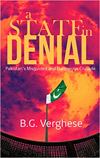|
Home |
Gandhi / the Man Behind the MetaphorMohandas: A True Story of a Man, A People and an Empire by Rajmohan Gandhi. Penguin/Viking, 2006. By B G Verghese Business Standard/ Book Review, 2007 Few men are so revered as Mohandas Karamchand Gandhi, Father of the Nation. Though deified, he is more remembered abroad than at home. Much has been written of him. Not content, his grandson, Rajmohan Gandhi, felt drawn to find the “true Man” behind the Metaphor. The result is “Mohandas”, an important critique, marked by integrity, keen insights and fresh interpretations but weighed down by sheer size. Rajmohan discusses Gandhi’s fads: vegetarianism, naturopathy, sex and chastity, abstinence, days of silence, his hard and almost clinical attitude towards his family, all part of his experiments with Truth. He was a deeply spiritual person, seeking the essence of every religion and respectful of all faiths, but essentially Hindu. Gandhi was a humanist. His doctrinal evolution through sarvodaya, antyodaya, satyagraha and non-violent passive resistance (“the moral equivalent of war”) or civil disobedience owed much to Ruskin, Emerson, Thoreau and Tolstoy. The final distillate, however, was uniquely Gandhian, his laboratories South Africa, his family and India. He was an intensely moral person but could be intolerant in his righteousness and authoritarian in defence of the higher dictates of his inner voice. There was incompleteness and inherent contradictions in many of Gandhi’s positions. In South Africa, he fought for Indian rights and for the coloureds, but never once raised his voice for the Blacks. This was a singular and inexplicable omission. His support for the Khilafat movement, even after its rejection by Attaturk’s Turkey, was naïve and betrayed a poor reading of history. It was motivated by the desire to unite Muslim and Hindu opinion around a common plank. Gandhi rightly objected to Jinnah’s claim to be sole representative of Muslim Indians but claimed to be the true spokesman of the “Untouchables” and would be so elected were there to be a referendum among them. He worked tirelessly for Hindu-Muslim unity but objected to his son, Manilal, marrying a Muslim. Ambedkar saw little justice for the Untouchables in Hindu society and sought separate electorates. But he had to yield when the Mahatma undertook a fast unto death, accepting reserved seats in lieu. It was Ambedkar’s firm belief that caste bred discrimination. Gandhi, however, stood for ending (ritual) untouchability but upheld caste, attributing discrimination to a sense of “high” and “low” that he personally disavowed. He thereby saw caste oppression as class discrimination and failed to put his immense influence behind this crucial reform though he wrote an editorial in “Harijan” entitled “Caste has to go”. When Ambedkar said he planned to convert to Buddhism to escape caste discrimination, Gandhi argued against it. Discussing conversion with some Christian missionaries in 1936, Gandhi said that some untouchables “can no more distinguish between the relative merits of Islam, Hinduism and Christianity, than a cow…”! Several people, Jagjivan Ram included, objected. Gandhi replied he meant no offence. The cow was a sacred animal, and it was the fault of caste Hindus that “thousands of Harijans had been left in a state where they could not understand the merits and demerits of different religions”. Likewise, Gandhi led peasant movements against coercion and exploitation by indigo planters in Champaran and land taxes in Gujarat. But he did not actively address fundamental issues of agrarian reform, displaying a certain status quoist class bias in this regard. While Gandhi championed the poor and worked for their uplift, did he inadvertently idealise poverty, as many in India still do? He dissuaded Manilal from studying medicine or law, telling him “ we are poor and wish to remain poor”. His thesis against “western civilisation” in “Hind Swaraj” was that it was based on machinery and technology, products of an acquisitive society greedy for ever more material possessions (consumption), leading inevitably to competition, litigation and violence. He extolled the simple life, would limit wants, advocated swadeshi and “embraced poverty”, advising industrialists to be public trustees of the wealth they created. Like his advice to Jews in Germany to confront the Nazis with non-violence, did his idealism sometimes disdain realism. Sarojini Naidu would later remark, it took an awful lot of money to keep Bapu poor. In October 1945, Gandhi wrote to Jawaharlal Nehru, his chosen “successor”, endorsing “the system of government spelt out in “Hind Swaraj”, though he envisioned new villages. Nehru rejected this view as “completely unreal”. The world had moved on. Rajmohan’s is a searchingly honest work. But does his assessment encapsulate the whole truth? The debate will continue. Yet, despite foibles and contradictions, Gandhi remains an inspirational figure.
|
||
| back to the top | |||
HOME | ABOUT THE AUTHOR | LIST OF ARTICLES | CONTACT | BOOKS See also AsianConversations.com 11-C Dewan Shree Apartments, 30 Ferozeshah Rd, New Delhi 110001, India
|


